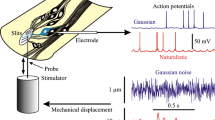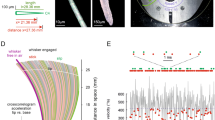Abstract
Mechanotransduction in the femoral tactile spine of the cockroach, Periplaneta americana, was examined as a function of displacement of the spine axially in its socket. Linear behaviour was analyzed by measurement of the frequency response function between displacement and action potential output using sinusoidal stimulation and random noise stimulation. The measured frequency response functions can be well fitted by a relationship which is a fractional power of complex frequency. This power was close to 0.5 for all experiments. To distinguish between the effects of nonlinearity and of inherent variability, the averaged responses of the preparation to repeated sequences of pseudorandom noise were compared to those from experiments in which continuous pseudorandom noise were used. The lack of sensitivity of the coherence function to these two methods of measurement suggests that mechanical stimuli are encoded into action potentials with a large signal-to-noise ratio. The low value of the coherence function which is characteristics of insect mechanoreceptors is therefore due to the strong non-linearity of their responses. To investigate the nonlinear properties of transduction, the second-order frequency response function of the tactile spine was measured for random noise stimulation experiments. Two models of the transduction process were considered in which a linear element with memory was cascaded with a nonlinear element without memory in the two possible configurations. Comparison of the experimental second-order frequency response functions with predictions based upon these two models and the measured first-order frequency response suggests that the transduction mechanism can be modelled by a linear element, which may be associated with the viscoelastic properties of the dendritic tubular body, and a zeromemory nonlinearity, which is most likely to be rectification by the dendritic membrane.
Similar content being viewed by others
References
Bendat, J.S., Piersol, A.G.: Measurement and analysis of random data. New York: Wiley & Sons 1968
Chapman, K.M.: Campaniform sensilla on the tactile spines of the legs of the cockroach. J. Exp. Biol. 41, 191–203 (1965)
Chapman, K.M., Mosinger, J.L., Duckrow, R.B.: The role of viscoelastic coupling in sensory adaptation in an insect mechano-receptor. J. Comp. Physiol. 131, 1–12 (1979)
Chapman, K.M., Pankhurst, J.H.: Conduction velocities and their temperature coefficients in sensory nerve fibres of cockroach legs. J. Exp. Biol. 46, 63–84 (1967)
Chapman, K.M., Smith, R.S.: A linear transfer function underlying impulse frequency modulation in a cockroach mechanoreceptor. Nature (London) 197, 699–700 (1963)
French, A.S.: Automated spectral analysis of neurophysiological data using intermediate magnetic tape storage. Comput. Programs Biomed. 3, 45–57 (1973)
French, A.S.: Practical nonlinear system analysis by Wiener kernel estimation in the frequency domain. Biol. Cybernetics 24, 111–119 (1976)
French, A.S.: Coherence improvement in white noise analysis by the use of a repeated random sequence generator. IEEE Trans. Biomed. Eng. 27, 51–53 (1980a)
French, A.S.: Phototransduction in the fly compound eye exhibits temporal resonances and a pure time delay. Nature (London) 283, 200–202 (1980b)
French, A.S., Butz, E.G.: Measuring the Wiener kernels of a nonlinear system using the fast Fourier transform. Int. J. Control 17, 529–539 (1973)
French, A.S., Holden, A.V.: Alias-free sampling of neuronal spike trains. Kybernetik 8, 165–171 (1971)
French, A.S., Holden, A.V., Stein, R.B.: The estimation of the frequency response function of a mechanoreceptor. Kybernetik 11, 15–23 (1972)
French, A.S., Sanders, E.J.: The mechanism of sensory transduction in the sensilla of the trochanteral hair plate of the cockroach, Periplaneta americana. Cell Tissue Res 198, 159–174 (1979)
French, A.S., Wong, R.K.S.: The responses of trochanteral hair plate sensilla in the cockroach to periodic and random displacements. Biol. Cybernetics 22, 33–38 (1976)
French, A.S., Wong, R.K.S.: Nonlinear analysis of sensory transduction in an insect mechanoreceptor. Biol. Cybernetics 26, 231–240 (1977)
Gaffal, K.P., Tichy, H., Theiss, J., Seelinger, G.: Structural polarities in mechanosensitive sensilla and their influence on stimulus transmission (arthropoda). Zoomorphology 82, 79–103 (1975)
Lee, Y.W., Schetzen, M.: Measurement of the Wiener kernels of a nonlinear system by cross-correlation. Int. J. Control 2, 237–254 (1965)
Lewis, C.T.: Structure and function in some external receptors. Symp. R. Entomol. Soc. London 5, 59–76 (1970)
Marmarelis, P.Z., Marmarelis, V.Z.: Analysis of physiological systems. The white noise approach. New York: Plenum Press 1978
Matsumoto, D.E., Farley, R.D.: Comparison of the ultrastructure of stimulated and unstimulated mechanoreceptors in the taste hairs of the blowfly Phaenicia serricata. Tiss. Cell 10, 63–76 (1978)
McIver, S.B.: Structure of cuticular mechanoreceptors of arthropods. Ann. Rev. Entomol. 20, 381–397 (1975)
Moore, R.K.: Travelling wave engineering. New York: McGraw-Hill 1960
Moran, D.T., Varela, F.G., Rowley, J.C.: Evidence for active role of cilia in sensory transduction. Proc. Natl. Acad. Sci USA 74, 793–797 (1977)
Pringle, J.W., Wilson, V.J.: The response of a sense organ to a harmonic stimulus. J. Exp. Biol. 29, 220–234 (1952)
Rescigno, A., Stein, R.B., Purple, R.L., Poppele, R.E.: A neuronal model for the discharge patterns produced by cyclic inputs. Bull. Math. Biophys. 32, 337–353 (1970)
Rice, M.J.: Insect mechanoreceptor mechanisms. In: Sensory physiology and behaviour. Galun, R., Hillman, P., Parnas, I., Werman, R. (eds.). New York: Plenum Press 1975
Sokolnikoff, I.S., Redheffer, R.M.: Mathematics of physics and modern engineering. New York: McGraw-Hill 1958
Stein, R.B., French, A.S., Holden, A.V.: The frequency response, coherence, and information capacity of two neuronal models. Biophys. J. 12, 295–322 (1972)
Thorson, J., Biederman-Thorson, M.: Distributed relaxation processes in sensory adaptation. Science 183, 161–172 (1974)
Thurm, U.: Steps in the transducer process of mechanoreceptors. Symp. Zool. Soc. London 23, 199–216 (1968)
von Schweidler, E.R.: Studien über die Anomalien im Verhalten der Dieletrika. Ann. Phys. (NY) 24, 711–770 (1907)
Wiener, N.: Nonlinear problems in random theory. New York: Wiley & Sons 1958
Author information
Authors and Affiliations
Rights and permissions
About this article
Cite this article
French, A.S. Sensory transduction in an insect mechanoreceptor: Linear and nonlinear properties. Biol. Cybernetics 38, 115–123 (1980). https://doi.org/10.1007/BF00356038
Received:
Issue Date:
DOI: https://doi.org/10.1007/BF00356038




